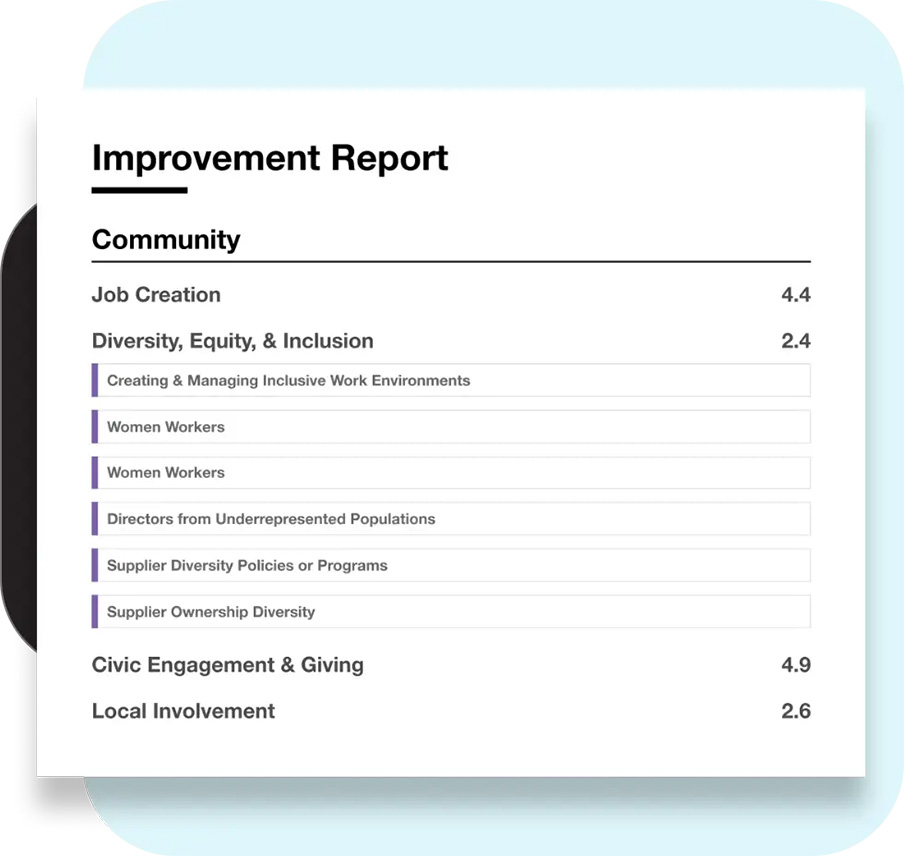
Some companies prioritizing ESG (Environmental Social Governance) are working to become B Corp certified -- a prestigious designation reserved for companies that promise to balance profits with purpose. In this guide, we’ll discuss B Corp basics and how they differ from C Corps, Benefit Corporations and nonprofits. We’ll also comprehensively review requirements and steps for certification.
Table of Contents
A B Corporation (also referred to as a “B Corp”) is a private certification offered by B Lab to for-profit companies that demonstrate high environmental and social performance while employing a governance structure that includes all stakeholders, not just shareholders.
B Corporations aspire to transform the global economy to benefit all people, communities and the planet. All performance is reported publicly on B Lab profiles.
Since a B Corp is a certification and not a legal business entity, it helps to refer to them as certified B Corporations or certified B Corps.
A C Corp (also known as a corporation) is the most common legal business structure. A “B Corp” is a certification, not a legal business structure. (A C Corp could file for Benefit Corp status. See more on Benefit Corporation below.)
B Corp certification is available to all legal business structures, not just corporations:
A certified B Corporation (B Corp) is a certification while a Benefit Corporation is a legal business status for a corporation, currently authorized in at least 40 U.S. states and the District of Columbia. Maryland was first to pass the legislation in 2010. Most recently, Alabama and Georgia passed the legislation in January 2021. Alaska, Michigan, Mississippi and North Carolina states currently do NOT have a benefit corporation or constituency statute, like Public Benefit Corporation (PBC) or Social Purpose Corporation (SPC), that explicitly allows directors to consider the interests of stakeholders.
Both “certified B Corporation” and “Benefit Corporation” are commonly referred to as “B Corp,” which can create some confusion. (For the purpose of this guide, unless otherwise stated, when “B Corp” is referenced, we are referring to the certification.)
It is possible for a certified B Corp to also be a Benefit Corp. In fact, certified B Corps are encouraged to file for Benefit Corporation status, if it’s available in their state. (This status fulfills the legal accountability requirements of B Corp certification.)
Although “Benefit Corporation” and “Certified B Corporation” are complementary, there are differences between the two:
| CERTIFIED B CORP | BENEFIT CORP | BOTH | |
|---|---|---|---|
| STRUCTURE | A business certification, not legally recognized | A legal business entity | Must file annual taxes on profits; no tax exemption |
| AVAILABILITY | Available globally to all businesses regardless of corporate structure | Only available to corporations in most U.S. states, Canada and a few other countries | Only available to for-profit companies |
| PERFORMANCE | Must achieve a minimum verified score of 80 on B Impact Assessment | Must file benefit reports annually or biannually based on state or country law | Strive to meet high ESG standards and publish ESG reports based on third-party frameworks |
| ACCOUNTABILITY | Must meet B Lab evolving standards and recertify every three years | Does not have to meet B Lab standards | Must consider impact on all stakeholders, not just shareholders |
| COST | Annual certification fees range from $1,000 - $50,000 USD based on revenue | State initial filing fees range from $70 - $350 USD |
B Lab is actually involved with both. B Lab is the certifying body for the B Corp Certification; they also developed the Benefits Corporation model used for legislation.
Both a B Corp and a nonprofit work toward doing public good. However, a nonprofit devotes 100% of resources to their mission, while a B Corp intends to make a profit. Nonprofits are currently not eligible for B Corp certification.
| NONPROFIT | B CORP | |
|---|---|---|
| RESOURCES | 100% toward achieving mission | Mixed allocation toward achieving good and a profit |
| GOVERNANCE | Accountable to a board | Accountable to financial and ESG governance |
| RAISE MONEY | Fundraising or grants | Sells products, services and/or stock in the company, acquires debt |
| REPORTING | Optional | Required |
B Corp certification is attractive for companies aspiring to reach ESG goals. However, it’s important to understand the advantages and disadvantages of certification before moving forward.
Is becoming a certified B Corp worth it? For many businesses who wish to prioritize sustainability and ESG, we believe yes. However, the process isn’t without its challenges.
Some things to consider when pursuing B Corp certification:
Given the significant investment of time and resources to achieve B Corp certification, some entities may choose another approach to live up to the ideals of the B Corp mission of balancing purpose and profits. Startups, nonprofits and other organizations can utilize ESG frameworks and ESG reporting to share their environmental, social and governance priorities and performance. With so many factors impacting the day-to-day operations of any organization, it is important to start with ESG strategy that helps an organization answer questions about the impact they wish to make on the world.
If there’s any question about B Corp benefits, it’s best to look at the growing number of companies that proudly promote their B Corp status. As of July 2022, there were over 5,325 certified B Corporations across 83 countries and 156 industries.
Below are some certified B Corporation examples with their current B Impact Score. Visit the B Corp Directory for a complete listing.
B Corp Clothing Brands
B Corp Beauty Brands
|
B Corp Food Brands
B Corp Tech Companies
B Corp Startups
|
Certification is a time and resource-intensive process that takes at least 12 months to complete. Only 1 in 3 applying actually get certified. Certifications then last three years. At the end of those three years, each business must recertify. (Companies should begin the recertification process in about two years to avoid certification lapse.)
The basic process is as follows:
In some cases, a site review or third-party audit may be required for certification.
B Corp certification requirements overview:
A company must be a for-profit business that’s been operating for at least 12 months. Startups that have been in business for fewer than 12 months can apply for pending B Corp certification.
Eligible businesses must then meet several performance, legal and transparency requirements to qualify for B Corp certification.
Companies must verify their social and environmental performance every three years by taking the B Impact Assessment and achieving a verified score of 80 points or above. Companies must also pass a disclosure review.
B Lab requires businesses to update their Articles of Incorporation and make structural changes to account for all stakeholders, not just shareholders, as part of governance. This means adding consideration of the impact of business decisions on customers, employees, the community, the environment, suppliers and shareholders. Certified B Corporations are not required to consider the interests of any particular group as dominant over others, but to take a comprehensive approach to decision-making in the stakeholder model of business.
Other legal requirements might be necessary. Use B Lab’s legal requirements tool to find specific requirements for your business entity type and country, region or state.
Businesses must publish their B Impact Report inside B Lab’s B Corp Directory to ensure public transparency.
All certified B Corp companies must pay a yearly fee based on gross annual revenue to keep their certification active. Fees start at $2,000 USD/year for companies making less than $5 million. The fees increase as revenue goes up. For instance, a company making $100 million to $174.9 million will need to pay a $30,000 annual fee. See the B Corp certification fee structure for details.
If your business meets eligibility and other requirements, completing the B Impact Assessment is the next step toward pursuing a B Corp certification.
The B Impact Assessment (BIA) is a tool that businesses can use to find their strengths, risks and opportunities in these five areas of impact:
The assessment is more than a questionnaire. Businesses can use the tool to benchmark performance against other businesses. The assessment also includes free tools for improving B Impact Scores such as best practice guides.
The B Impact Assessment can take anywhere from three hours for a small business to several weeks for a large corporation to complete. It depends on number of employees, company age, operating locations and ease of gathering the required supporting documentation.
B Lab recommends that companies estimate answers their first time through and then revisit accordingly. The B Lab team will help determine where additional documentation is needed. Companies can save their BIA progress and come back as often as needed to complete the assessment.
Once assessments are completed, B Lab’s evaluation and verification process can take 4-8 weeks. There is a “waiting list” of certification applicants and the entire process from start to finish usually takes 6-12 months to complete.
The B Impact Assessment asks up to 250 questions pertaining to the five areas of impact -- community, customers, environment, governance and workers.
Detailed supporting documentation for question answers is required throughout the assessment and will be verified by your assigned B Corp Standards Analyst. Below are some common documents recommended by B Lab to gather in advance:
A B Impact Score measures a company’s performance across the five impact areas (community, customers, environment, governance and workers) via the B Impact Assessment. Scores range from 0 up to 200. Scoring is complex and customized based on the company’s track (i.e., size, sector, location), so the highest potential score varies.
To certify, companies must score at least 80 points on the B Impact Assessment. This is a “good” score and is notably higher than the median score (50.9) for all companies completing the assessment.
B Lab also recognizes high-scoring certified B Corps in their annual “Best for the World” (BFTW) lists which include the global top 5% of certified B Corps across the five impact areas:

Companies must fulfill BFTW requirements by April 30th each year to qualify.
The B Impact Assessment (BIA) will include score comparisons for your company’s country location, industry sector and size across each of the five impact areas.
It’s not uncommon for companies to receive a score under the 80-point threshold after taking the assessment for the first time. Whether the minimum score for certification was met or not, there are multiple ways companies can increase their B Impact Score:

Becoming a certified B Corp company is a complex and daunting process. Contact our ESG consultants today to learn more about certification and how we can help.
From risk assessments and framework selection to report guidance and independent assurance of data, our team can assist your ESG strategy and efforts.